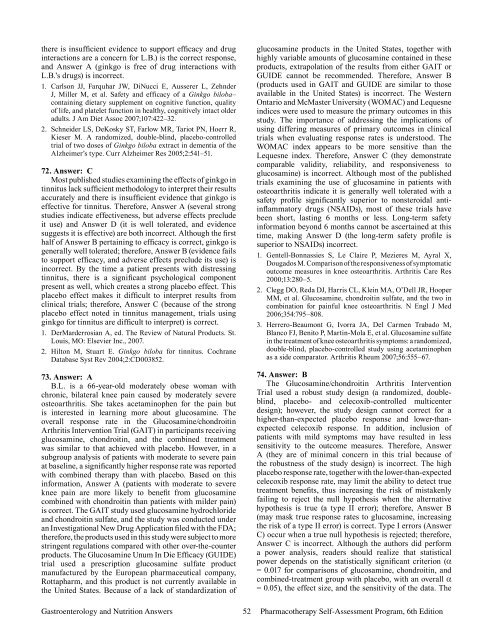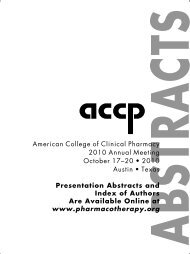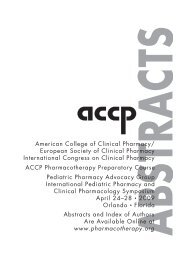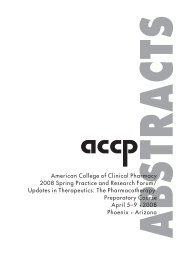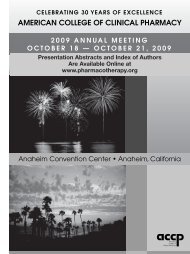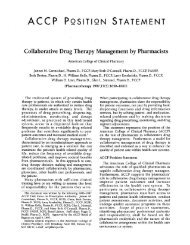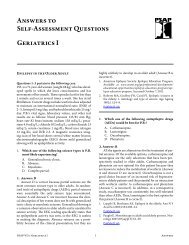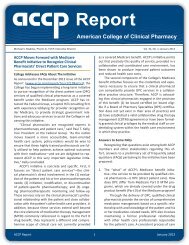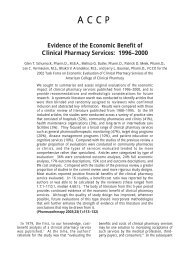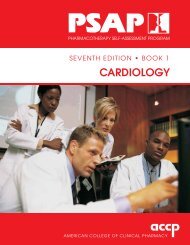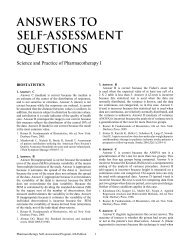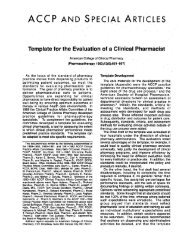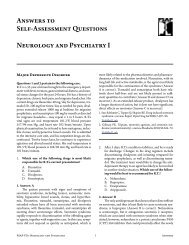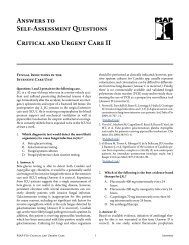Answers to Self-Assessment Questions - ACCP
Answers to Self-Assessment Questions - ACCP
Answers to Self-Assessment Questions - ACCP
You also want an ePaper? Increase the reach of your titles
YUMPU automatically turns print PDFs into web optimized ePapers that Google loves.
there is insufficient evidence <strong>to</strong> support efficacy and drug<br />
interactions are a concern for L.B.) is the correct response,<br />
and Answer A (ginkgo is free of drug interactions with<br />
L.B.’s drugs) is incorrect.<br />
1. Carlson JJ, Farquhar JW, DiNucci E, Ausserer L, Zehnder<br />
J, Miller M, et al. Safety and efficacy of a Ginkgo biloba–<br />
containing dietary supplement on cognitive function, quality<br />
of life, and platelet function in healthy, cognitively intact older<br />
adults. J Am Diet Assoc 2007;107:422–32.<br />
2. Schneider LS, DeKosky ST, Farlow MR, Tariot PN, Hoerr R,<br />
Kieser M. A randomized, double-blind, placebo-controlled<br />
trial of two doses of Ginkgo biloba extract in dementia of the<br />
Alzheimer’s type. Curr Alzheimer Res 2005;2:541–51.<br />
72. Answer: C<br />
Most published studies examining the effects of ginkgo in<br />
tinnitus lack sufficient methodology <strong>to</strong> interpret their results<br />
accurately and there is insufficient evidence that ginkgo is<br />
effective for tinnitus. Therefore, Answer A (several strong<br />
studies indicate effectiveness, but adverse effects preclude<br />
it use) and Answer D (it is well <strong>to</strong>lerated, and evidence<br />
suggests it is effective) are both incorrect. Although the first<br />
half of Answer B pertaining <strong>to</strong> efficacy is correct, ginkgo is<br />
generally well <strong>to</strong>lerated; therefore, Answer B (evidence fails<br />
<strong>to</strong> support efficacy, and adverse effects preclude its use) is<br />
incorrect. By the time a patient presents with distressing<br />
tinnitus, there is a significant psychological component<br />
present as well, which creates a strong placebo effect. This<br />
placebo effect makes it difficult <strong>to</strong> interpret results from<br />
clinical trials; therefore, Answer C (because of the strong<br />
placebo effect noted in tinnitus management, trials using<br />
ginkgo for tinnitus are difficult <strong>to</strong> interpret) is correct.<br />
1. DerMarderrosian A, ed. The Review of Natural Products. St.<br />
Louis, MO: Elsevier Inc., 2007.<br />
2. Hil<strong>to</strong>n M, Stuart E. Ginkgo biloba for tinnitus. Cochrane<br />
Database Syst Rev 2004;2:CD003852.<br />
73. Answer: A<br />
B.L. is a 66-year-old moderately obese woman with<br />
chronic, bilateral knee pain caused by moderately severe<br />
osteoarthritis. She takes acetaminophen for the pain but<br />
is interested in learning more about glucosamine. The<br />
overall response rate in the Glucosamine/chondroitin<br />
Arthritis Intervention Trial (GAIT) in participants receiving<br />
glucosamine, chondroitin, and the combined treatment<br />
was similar <strong>to</strong> that achieved with placebo. However, in a<br />
subgroup analysis of patients with moderate <strong>to</strong> severe pain<br />
at baseline, a significantly higher response rate was reported<br />
with combined therapy than with placebo. Based on this<br />
information, Answer A (patients with moderate <strong>to</strong> severe<br />
knee pain are more likely <strong>to</strong> benefit from glucosamine<br />
combined with chondroitin than patients with milder pain)<br />
is correct. The GAIT study used glucosamine hydrochloride<br />
and chondroitin sulfate, and the study was conducted under<br />
an Investigational New Drug Application filed with the FDA;<br />
therefore, the products used in this study were subject <strong>to</strong> more<br />
stringent regulations compared with other over-the-counter<br />
products. The Glucosamine Unum In Die Efficacy (GUIDE)<br />
trial used a prescription glucosamine sulfate product<br />
manufactured by the European pharmaceutical company,<br />
Rottapharm, and this product is not currently available in<br />
the United States. Because of a lack of standardization of<br />
Gastroenterology and Nutrition <strong>Answers</strong><br />
52<br />
glucosamine products in the United States, <strong>to</strong>gether with<br />
highly variable amounts of glucosamine contained in these<br />
products, extrapolation of the results from either GAIT or<br />
GUIDE cannot be recommended. Therefore, Answer B<br />
(products used in GAIT and GUIDE are similar <strong>to</strong> those<br />
available in the United States) is incorrect. The Western<br />
Ontario and McMaster University (WOMAC) and Lequesne<br />
indices were used <strong>to</strong> measure the primary outcomes in this<br />
study. The importance of addressing the implications of<br />
using differing measures of primary outcomes in clinical<br />
trials when evaluating response rates is unders<strong>to</strong>od. The<br />
WOMAC index appears <strong>to</strong> be more sensitive than the<br />
Lequesne index. Therefore, Answer C (they demonstrate<br />
comparable validity, reliability, and responsiveness <strong>to</strong><br />
glucosamine) is incorrect. Although most of the published<br />
trials examining the use of glucosamine in patients with<br />
osteoarthritis indicate it is generally well <strong>to</strong>lerated with a<br />
safety profile significantly superior <strong>to</strong> nonsteroidal antiinflamma<strong>to</strong>ry<br />
drugs (NSAIDs), most of these trials have<br />
been short, lasting 6 months or less. Long-term safety<br />
information beyond 6 months cannot be ascertained at this<br />
time, making Answer D (the long-term safety profile is<br />
superior <strong>to</strong> NSAIDs) incorrect.<br />
1. Gentell-Bonnassies S, Le Claire P, Mezieres M, Ayral X,<br />
Dougados M. Comparison of the responsiveness of symp<strong>to</strong>matic<br />
outcome measures in knee osteoarthritis. Arthritis Care Res<br />
2000;13:280–5.<br />
2. Clegg DO, Reda DJ, Harris CL, Klein MA, O’Dell JR, Hooper<br />
MM, et al. Glucosamine, chondroitin sulfate, and the two in<br />
combination for painful knee osteoarthritis. N Engl J Med<br />
2006;354:795–808.<br />
3. Herrero-Beaumont G, Ivorra JA, Del Carmen Trabado M,<br />
Blanco FJ, Beni<strong>to</strong> P, Martin-Mola E, et al. Glucosamine sulfate<br />
in the treatment of knee osteoarthritis symp<strong>to</strong>ms: a randomized,<br />
double-blind, placebo-controlled study using acetaminophen<br />
as a side compara<strong>to</strong>r. Arthritis Rheum 2007;56:555–67.<br />
74. Answer: B<br />
The Glucosamine/chondroitin Arthritis Intervention<br />
Trial used a robust study design (a randomized, doubleblind,<br />
placebo- and celecoxib-controlled multicenter<br />
design); however, the study design cannot correct for a<br />
higher-than-expected placebo response and lower-thanexpected<br />
celecoxib response. In addition, inclusion of<br />
patients with mild symp<strong>to</strong>ms may have resulted in less<br />
sensitivity <strong>to</strong> the outcome measures. Therefore, Answer<br />
A (they are of minimal concern in this trial because of<br />
the robustness of the study design) is incorrect. The high<br />
placebo response rate, <strong>to</strong>gether with the lower-than-expected<br />
celecoxib response rate, may limit the ability <strong>to</strong> detect true<br />
treatment benefits, thus increasing the risk of mistakenly<br />
failing <strong>to</strong> reject the null hypothesis when the alternative<br />
hypothesis is true (a type II error); therefore, Answer B<br />
(may mask true response rates <strong>to</strong> glucosamine, increasing<br />
the risk of a type II error) is correct. Type I errors (Answer<br />
C) occur when a true null hypothesis is rejected; therefore,<br />
Answer C is incorrect. Although the authors did perform<br />
a power analysis, readers should realize that statistical<br />
power depends on the statistically significant criterion (a<br />
= 0.017 for comparisons of glucosamine, chondroitin, and<br />
combined-treatment group with placebo, with an overall a<br />
= 0.05), the effect size, and the sensitivity of the data. The<br />
Pharmacotherapy <strong>Self</strong>-<strong>Assessment</strong> Program, 6th Edition


